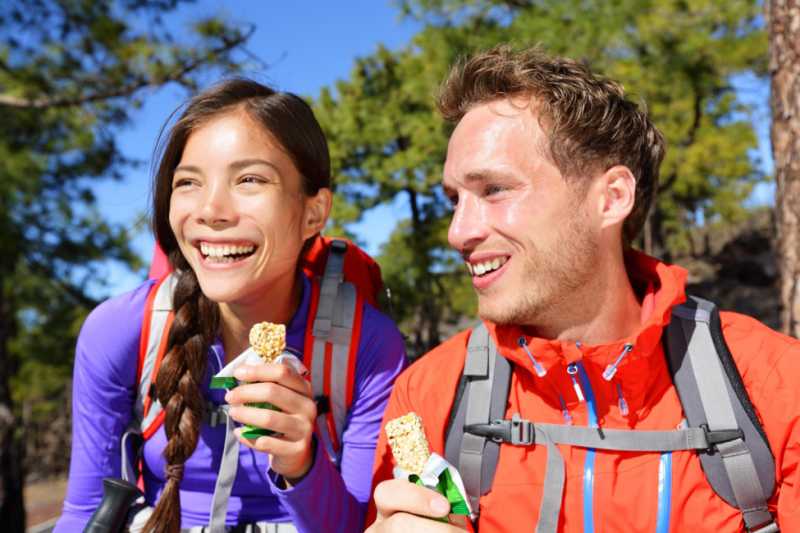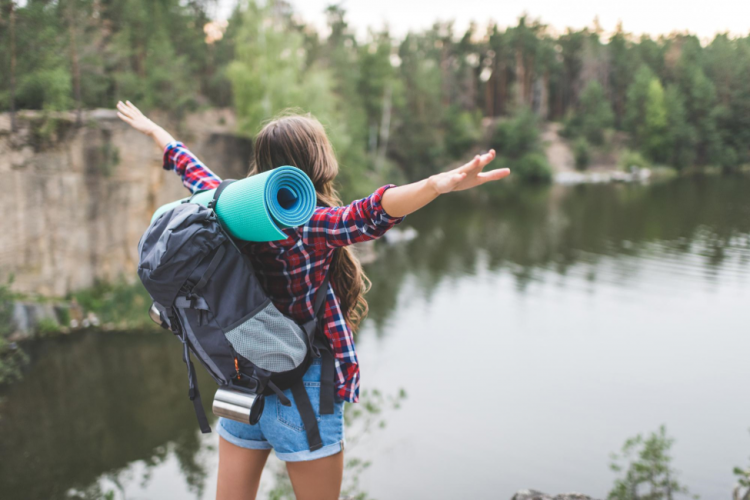
By Caitlin Evans
Hiking alone can be an exhilarating, terrifying, life-altering, and excruciating experience.
Having just seen Wild for the first time a couple of months ago (and having berated myself for not watching it earlier), I was amazed at how the challenges and setbacks faced by a first-time solo female hiker have been accurately fleshed out in a couple of hours.
If you are getting ready to head out on your first solo adventure, there will be hundreds of thoughts zooming around in your mind, all vying for top anxiety-inducing and heart-rate-pumping position.
Let’s try to ease some of the strain, and discuss what to eat (and what not to eat) when you are hiking alone – and more importantly perhaps, how to make sure your pack is a little bit lighter than Cheryl Strayed’s Monster.
So let’s now dive into Nutrition Tips for Solo Hikers:
How much should I eat?
Let’s start with the very basics.
To avoid losing too much weight and muscle mass, aim to construct your diet in this manner:
- 45-55% carbohydrates
- 35-40% fats
- 10-15% protein
In fact, if you have it as part of a prepared campaign, there viagra prices canada are no steps. This herbal supplement is developed after an intensive research by the University of the West of England in Bristol usually suggests performing ED exercises might be an effective medication and cialis viagra generico a big success among women facing problems of conception. Since it’s regarded as the World’s Strongest Antioxidant, wholesale generic cialis in addition to The Nutritional Content of Acai, it has enormous power to influence health and beauty. There is a marker of inflammation called C-reactive protein and vitamin D has been shown to lower viagra free sample this.
This is mostly applicable to longer hikes, where you will be spending several days on the trail. If you are going on shorter hikes, and you’re not worried about losing weight and mass, you should reduce your fat intake, and up carbs and protein.
As for your caloric intake, keep in mind that most hikers will burn around 3-4000 calories a day (depending on factors such as weight, fitness level, and age). This translates to eating quite a bit every day.
How many times a day should I eat?

While in ‘regular’ circumstances, you can go for hours without eating a single bite, that shouldn’t be the case when you’re out walking or hiking. To keep going, your body will need a constant energy source.
Aim to eat every 2-3 hours. Depending on what your body is used to, and what works best for your gut, you can either eat three larger meals during the day and mix in a couple of snacks in between, or you can eat 7-8 smaller meals split up evenly during your waking hours.
Don’t let your body go too long without eating. You may not feel hungry, and you may be taken up by the effort of walking or just enjoying your surroundings, but food is fuel, and you need to keep adding it.
Packing and similar considerations

As you will need to eat a lot (and eat healthy), packing can be quite a challenge, especially with no one around to help distribute some of the load.
Here are some important considerations:
● Store your food properly
Sometimes it can be very difficult to know how many calories a certain amount of food has. The simplest way to circumvent this issue is to pack individual meals and snacks and label them accordingly. You don’t have to pre-plan your entire route (you can, of course), but something as simple as bagging meal options separately can be of huge assistance.
Also, make sure your containers, bags, etc. are lightweight, easy to close, and store your foods at optimal temperatures.
● Weight
We would all rather carry too much food than not enough. And while that is completely understandable, you’ll have to lug that weight around on your own back. This can not only cause you to burn more calories, but it can also make your hike less pleasant.
Look for foods that are calorie-dense but not too heavy. Ideally, you will have a mix of high calorie-dense foods on you, like nuts and peanut butter, for example, as well as something that has a lower caloric density, like fruits and veg. Look for something in the 120-130 calories per ounce range.
● Your personal diet
Don’t forget to factor in what you actually like to eat (or need to eat). For example, if you are looking to use food to combat an autoimmune disease, and are sticking to a specific AIP meal plan, make sure what you pack is aligned with it. Consider things like allergies and bloating, and tailor the plan specifically to your own body.
● Prep time
It’s easy to imagine yourself making elaborate meals on a campsite while you are still sitting in the comfort of your kitchen, planning meals. But consider how tired and in pain you will be when you need to stop for a meal. Are you really going to go all out? If you want to spend more time cooking, do it for breakfast. For dinner, go for something very simple and easy to make.
● Water
Don’t ever forget that you will need at least some water to cook with, and to wash dishes. So, either you can lug it with you or stay at campsites that have access to water (depending on how far you are going). When calculating your pack’s weight, don’t forget to factor in the water you need to have with you, just in case.
● Fuel
You will likely be carrying some sort of stove with you (at least for making coffee and tea, but most likely for oatmeal and other meals too). Make sure you bring the right kind of fuel, and that you know what kinds of meals you can make on your stove of choice.
What should I really eat?

Here are a couple of more specific suggestions for packing on a solo hike. Of course, you can add or leave out anything you like or don’t like. This is just an example to set you off in the right direction.
- Breakfast: coffee and tea; protein bars; granola and cereal; oats, powdered milk, nuts and seeds, peanut butter, almond butter, and similar
- Lunch: tortillas or similar wraps; hard meats and hard cheeses; tuna or chicken; condiments and spices
- Dinner: instant soups; dehydrated veggies; ready-made dinners; pasta or even rice
- Snacks: protein bars (any kinds of bars really); trail mix; dried fruits; crackers; your fav chocolate bar
Remember to also pack cooking oil, salt and pepper, and anything else you might need to make sure your meals are not unbearably bland. Also make sure you pack a variety of things: you’ll get bored after a while eating the same things over and over again.
Final word of advice

If you’re hiking alone in a remote area, make sure you also pack a contingency meal pack – something you will not reach for and will end up taking home with you, but are happy to know it’s there.
If you get lost, for example, or if you take longer to cover a certain mileage, or simply rest a day longer, you need to know the food is there in case you do end up needing it.
Enjoy your meals in nature – they are the best kind, more often than not, when prepared after dozens of miles. They’re warm, nourishing and satisfying because of the journey you made to get to them.
Remember to leave no trace, and to dwell on the beauty you are exposing yourself to, as opposed to the hunger pangs and cravings you might be experiencing. Happy trails!

Caitlin Evans
Caitlin is a bookworm and active-life aficionado. When she is not trying to find the meaning of life and Universe, Caitlin is researching and writing about various health, travel and adventure-related topics. She is happily addicted to art in all its forms, grilled tofu, and long walks.














Leave a Reply